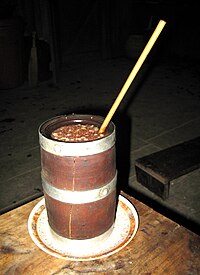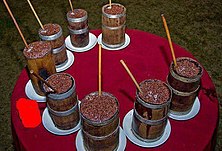Tongba
 Nepalesetongba in its namesake vessel. | |
| Type | alcoholic beverage |
|---|---|
| Country of origin | Limbuwan(present dayEastern Nepal,Sikkim) |
| Region of origin | Nepal,Sikkim,Darjeeling district |
| Introduced | Limbu people |
| Alcohol by volume | 2–5% |
| Proof (US) | 4–10° |
| Colour | milky white |
| Ingredients | millet,yeast,wateretc. |
| Related products | Chhaang |
Tongba(Nepali:तोङबाpronounced[toŋba]) is amillet-basedalcoholic beveragefound in the eastern mountainous region ofNepal,Bhutanand neighbouring Indian regions ofSikkimandDarjeeling.[1][2] [3]]; offering it is a sign of respect to a guest, and the drink is also an important element of special occasions and festivals. It is a soft alcoholic drink drank in Tibet for centuries, evidence being the wooden container it is made/drank in. It is also considered thetraditionalandindigenousdrink of theLimbu people.[3]
Preparation
[edit]
Tongbais actually the name of the vessel that holds the fermented millet beverage known asmandokpenaa thee.[4]Tongba is prepared from brown finger millet (Eleusine coracana,also known as ragi in India or kodo in Nepal) grown in hilly regions, and it is cooked and combined with traditionally cultured khesung, which is a microbial colony or starter culture. 'Khesung' is the Limbu version of the Nepali term 'murcha'; the Lepchas call it 'thamik', and Bhutias refer to it as 'phab'.
Ethno-medicinal properties
[edit]Tongba is a fermented millet beer from the Himalayas that contains biologically active components that may have therapeutic properties againsthigh-altitude illnesses.[5]Tongba is made by steeping fermented millet for a few minutes, then sucking the resulting cloudy liquid through a bamboo straw with a seed-filtering bottom. It's slightly alcoholic, smooth, and has a mild, milky, mushroomy taste with some bready hints.[6][7]
Tongba is a staple for travelers who carry their meals on their backs. It's also good for people who live in colder regions because it helps with digestion and boosts immunity.
Tongba contains glycoside, amino acids, fatty acids, terpenoids, and phenol, which have antioxidant and antibacterial potential[8]and therapeutic properties againsthigh-altitude illnessesincluding body moisture retention property in high-altitude cold and dry weather. Studies have also shown that tongba is metabolomically similar to Japanesesake.[5]
See also
[edit]References
[edit]- ^Easen, Nick (2004-03-01)."Mountain High - TIME".time. Archived fromthe originalon October 15, 2009.Retrieved2009-08-29.
- ^P.53 Nepalese Cooking By Lauren Baird, 2011
- ^abMAHARJAN, UJJWALA (2011-12-16)."Sipping hot Tongba in cold winter - My Republica".myrepublica. Archived fromthe originalon 2016-09-18.Retrieved2014-08-25.
- ^P.75 Handbook of Plant-Based Fermented Food and Beverage Technology, Second Edition By Y. H. Hui, E. Özgül Evranuz CRC Press, 17 May 2012
- ^abMajumder, S.; Chakraborty, S.; Ghosh, A.; Bhattacharya, M. (2022-12-01)."The Himalayan ethnic beverage tongba with therapeutic properties in high-altitude illnesses and metabolomic similarities to Japanese sake".Acta Universitatis Sapientiae, Alimentaria.15(1): 67–83.doi:10.2478/ausal-2022-0006.ISSN2066-7744.
- ^dccrossley (2016-01-04)."Tongba, A Study of Emptiness".David Crossley's Wide World of Wine.Retrieved2024-04-20.
- ^"Nepal's Bottomless Beer".Atlas Obscura.Retrieved2024-04-20.
- ^Majumder, Soumya; Ghosh, Arindam; Saha, Sumedha; Acharyya, Sukanya; Chakraborty, Sourav; Subba, Preeti; Nandi, Sudeshna; Sarkar, Sahadeb; Bhattacharya, Malay (2024-02-01)."In vitro bioactivities and gastrointestinal simulation validate ethnomedicinal efficacy of five fermented kodo-based Himalayan traditional drinks and bioaccessibility of bioactive components".Food Production, Processing and Nutrition.6(1): 4.doi:10.1186/s43014-023-00184-7.ISSN2661-8974.
